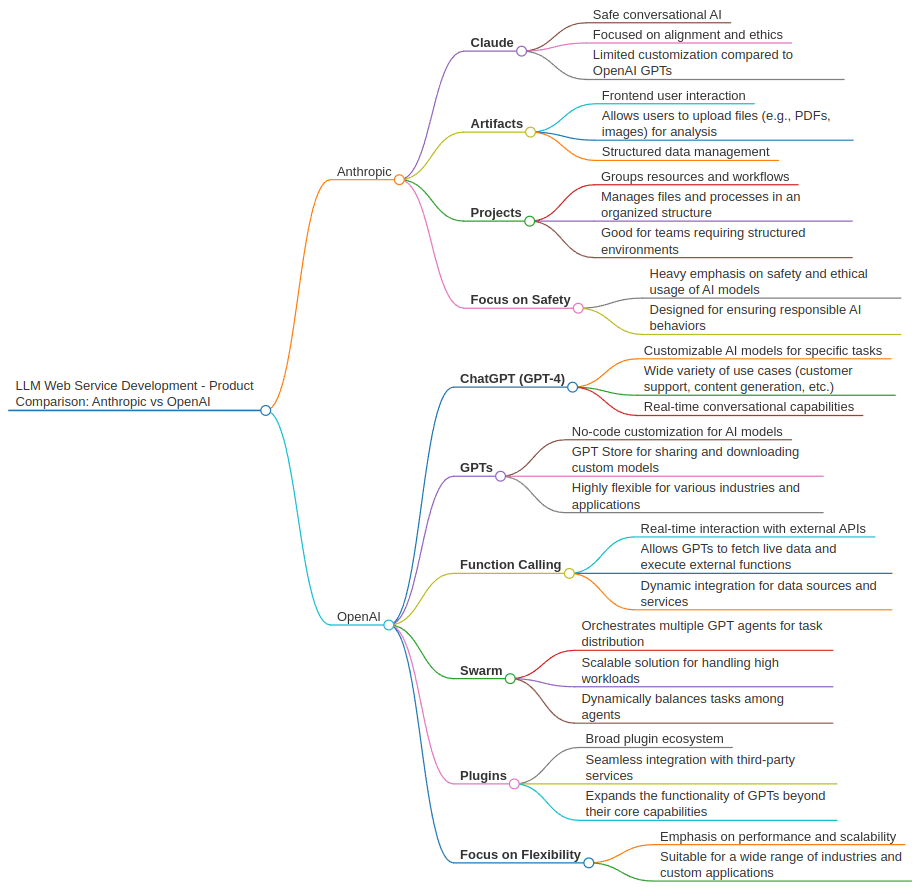Anthropic Projects vs. OpenAI GPTs: A Comparison for LLM-Based Web Service Development
As AI continues to evolve, organizations are seeking the best platforms to build scalable, efficient, and secure web services using large language models (LLMs). Two key players in this space are Anthropic with their Claude model and Projects feature, and OpenAI with their well-known ChatGPT and customizable GPTs. Both offer powerful tools, but they take different approaches to customization, integration, and project management.
In this post, we’ll explore the differences between Anthropic’s Projects and OpenAI’s GPTs, and how each platform can support the development of advanced AI-powered web services. We’ll also compare features like customization, external data integration, and scalability.
What Are Anthropic Projects?
Anthropic’s Projects provide a structured way to organize and manage AI usage by grouping resources, artifacts (such as files and external data), and workflows under a single environment. This setup is particularly useful for teams or developers working on large-scale AI implementations, as it helps keep tasks and resources organized for more efficient development.
The Projects feature allows users to: - Organize resources and workflows. - Integrate artifacts (files, data) directly into the project. - Structure different tasks or workflows within the same environment.
This built-in project management system is designed to simplify collaboration and the handling of external data, which is essential for efficient development in larger, more complex AI applications.
How Does OpenAI Compare?
On the other hand, OpenAI provides developers with extensive flexibility through their ChatGPT and GPTs ecosystem. GPTs allow users to customize AI models for specific tasks, all within a no-code environment, and can be shared or deployed through the GPT Store. OpenAI doesn’t have a built-in project management system like Anthropic’s Projects, but users can still organize resources, workflows, and model interactions independently, often through their APIs or external tools.
Let’s dive into a detailed comparison of the two platforms:
Comparison Table: Anthropic Projects vs. OpenAI GPTs
| Feature | Anthropic (Claude & Projects) | OpenAI (ChatGPT & GPTs) |
|---|---|---|
| Primary Model | Claude | ChatGPT (GPT-4) |
| Projects | Projects for organizing AI usage by grouping resources, artifacts, and workflows | No direct equivalent; GPTs and API usage managed independently with user-defined projects |
| Customization of Models | Limited customization; structured via Projects | GPTs allow full customization and fine-tuning for specific tasks |
| Artifacts (External Data Handling) | Artifacts for file uploads and data interaction | File upload + ADA (Advanced Data Analysis) for data interaction |
| Project Management | Built-in project organization and resource grouping | No built-in project grouping; managed externally via API workflows or GPT organization |
| Function Calling | Not as prominently integrated | Function Calling available for external function interaction |
| Integration with External Data | Artifacts and Projects to manage external data | Function Calling, File Upload, Plugins |
| Ease of Use (No-code Customization) | Project organization focuses on resource grouping | GPTs offer no-code customization for various tasks |
| Store/Marketplace for Custom Models | Not available | GPT Store for sharing and downloading custom GPTs |
| Scalability | Project-based scaling and resource management | High scalability via Swarm and GPT orchestration with Function Calling |
| Development Ecosystem | Project-oriented resource management and artifact handling | Extensive ecosystem with APIs, GPT Store, and Plugins |
Choosing the Right Platform for Your Project
The choice between Anthropic Projects and OpenAI GPTs depends largely on your development goals and the needs of your team:
Anthropic Projects are an excellent choice if you’re working on large, collaborative AI projects where resource organization and structure are essential. Its built-in management tools make it easier for teams to keep track of data and workflows.
OpenAI GPTs are more suited for teams that require flexibility and customization. With GPT Store, no-code customization, and rich plugin integration, OpenAI offers a broad ecosystem for developers looking to build AI-powered services tailored to specific industries or use cases.
Key Takeaways:
- Customization: OpenAI’s GPTs provide much more flexibility and customization options compared to Anthropic, which is more focused on safety and structure.
- Data Handling: Anthropic’s Artifacts and Projects offer a simple way to manage files and external data, while OpenAI provides Function Calling and advanced file handling with broader plugin support.
- Scalability: OpenAI’s Swarm and GPT orchestration allow for dynamic scaling of tasks and AI models, giving developers the ability to handle high traffic and large-scale data processing.
Conclusion
Both platforms are powerful tools for LLM-based web service development, but they cater to different types of users. Anthropic Projects emphasize structure and safety, making them ideal for larger, organized teams. Meanwhile, OpenAI GPTs excel in customization, flexibility, and scalability, offering developers a versatile toolkit for building tailored AI solutions.
If your team is looking for maximum flexibility with a vibrant ecosystem of plugins and shared models, OpenAI may be the right choice. However, if your priority is maintaining a structured environment with a focus on safe AI usage, Anthropic Projects might be more aligned with your needs.
For more information on these platforms, explore their offerings here:
- Anthropic Claude & Projects
- OpenAI ChatGPT & GPTs
Happy building!
